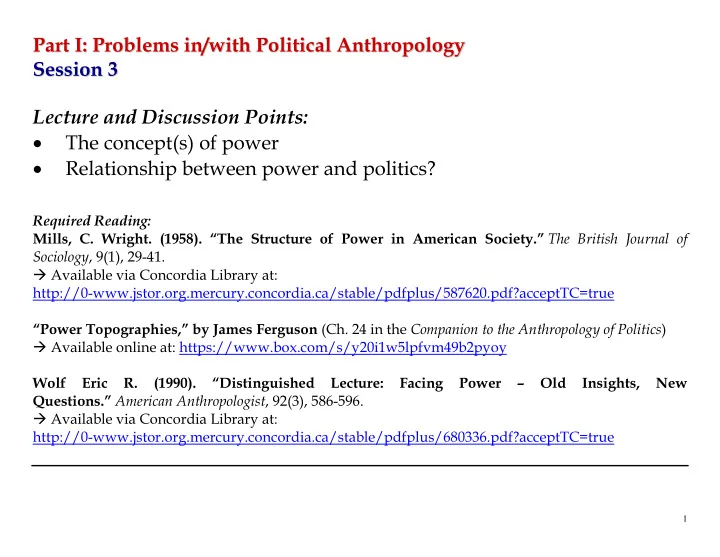

Pa ar rt t I I: : P Pr ro ob bl le em ms s i in n/ /w wi it th h P Po ol li it ti ic ca al l A An nt th hr ro op po ol lo og gy y P Se es ss si io on n 3 3 S Lecture and Discussion Points: • The concept(s) of power • Relationship between power and politics? Required Reading: Mills, C. Wright. (1958). “The Structure of Power in American Society.” The British Journal of Sociology , 9(1), 29-41. � Available via Concordia Library at: http://0-www.jstor.org.mercury.concordia.ca/stable/pdfplus/587620.pdf?acceptTC=true “Power Topographies,” by James Ferguson (Ch. 24 in the Companion to the Anthropology of Politics ) � Available online at: https://www.box.com/s/y20i1w5lpfvm49b2pyoy Wolf Eric R. (1990). “Distinguished Lecture: Facing Power – Old Insights, New Questions.” American Anthropologist , 92(3), 586-596. � Available via Concordia Library at: http://0-www.jstor.org.mercury.concordia.ca/stable/pdfplus/680336.pdf?acceptTC=true 1
Mills, C. Wright. (1958). “The Structure of Power in American Society.” The British Journal of Sociology , 9(1), 29-41. 1. What is power? 2. What is the power elite (in the U.S. context)? 3. How does that power come about? 4. What does the study of less-than-elite groups suggest about our understandings of power, democracy, etc., and about us as researchers? 5. What are middle-level politics in the U.S., and what power does the individual have in that context? 6. What does Mills think about “checks and balances” in the U.S. political system? 7. Does the U.S. have a “shadow government” in Mills’ view? 8. What is the situation, and the power of “the public” in the U.S.? 9. What are the necessary elements of the political structure of the modern democratic state? 2
“Power Topographies,” by James Ferguson (Ch. 24 in the Companion to the Anthropology of Politics ) 1. Why does Ferguson argue that rising interest in “civil society” is a fad, and what are the problems that form part of that fad? 2. Ferguson argues against a “vertical topography of power.” How does his treatment of power compare then with Mills’? 3. How does Ferguson maintain that the “civil society” focus legitimates anti- democratic politics? 4. Ferguson asks: “What if we question the self-evident ‘verticality’ of the relation of state to society, displace the primacy of the nation-state frame of analysis, and rearrange the imaginary space within which civil society can be so automatically ‘interposed between’ higher and lower levels?” What is his answer and what is your assessment of his answer? 5. What does Ferguson think of how “civil society” has been written about with respect to Africa? 6. Can we accurately depict the state as separate and opposed to civil society in Africa? Always, sometimes, never? 3
7. Elections simulate democracy in Zambia. What does that mean? How does this work? 4
Wolf Eric R. (1990). “Distinguished Lecture: Facing Power – Old Insights, New Questions.” American Anthropologist , 92(3), 586-596. 1. What are Wolf’s four modes of power, and which one in particular does he seem to emphasize? 2. Why should we need to specify different “kinds” of “power”? Do you think the discussion of power is deepened or extended by this specification? 3. How is the control of labour and capital political and not “economic”? 4. Looking at the works of Steward, Gluckman, and Adams, summarize in one sentence what Wolf thinks the major contribution of each one has been to the study of the operation of power. 5. Organization and signification: why are these important foci for Wolf? How does he think they should be understood? 5
Recommend
More recommend